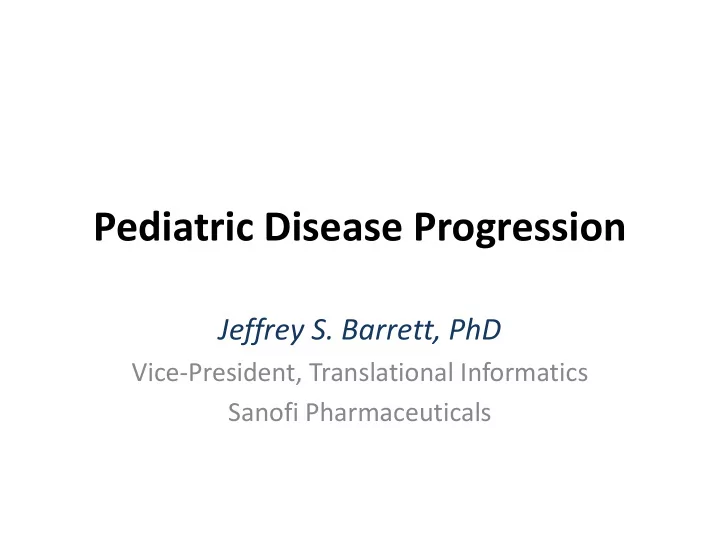

Pediatric Disease Progression Jeffrey S. Barrett, PhD Vice-President, Translational Informatics Sanofi Pharmaceuticals
The Challenge to Sanity What’s really important here • How can I judge if the adult or pediatric disease are similar if I don’t understand the adult disease progression? – How should this (disease progression) be defined and/or quantified? • What are reasonable criteria for assessing “similarity” of disease? – Do criteria change with the disease? How? Why?
The Challenge to Sanity Why do we care? Do I really have the data to answer that question?
Disease Progression What’s Important – Common Terms of Interest • Onset / diagnosis • Prevalence • Variation in disease manifestation (phenotype) • Genetic predisposition (genotype) • Clinical manifestation (signs and symptoms) • Disease stage / severity • Comorbidities of disease and progression
Disease Progression Current Research vs Regulatory Needs • Most of the research focus has been about measuring the right outcomes that define pediatric disease progression – Emphasis on tailoring treatment options precision medicine for children. • Comparison of pediatric and adult progression is not a major point of interest (though some are clearly engaged)
Examples of Current Efforts Predictors of Disease Progression in Pediatric Dilated Cardiomyopathy . • Molina KM et al., Circ Heart Fail. 2013; 6(6): 1214–1222. Discordant Impact of HLA on Viral Replicative Capacity and Disease • Progression in Pediatric and Adult HIV Infection . Adland et al., PLoS Pathog. 2015 Jun; 11(6): e1004954. Disease progression in pediatric multiple sclerosis : disparities between • physical and neurocognitive outcomes. Yeh. Expert Rev Neurother. 2011 Mar;11(3):433-40. Etiology and pediatric chronic kidney disease progression : Taiwan • Pediatric Renal Collaborative Study. Chiou. J Formos Med Assoc. 2015. pii: S0929-6646(15)00275-2. Pediatric non alcoholic fatty liver disease : old and new concepts on • development, progression, metabolic insight and potential treatment targets. Giorgio et al. BMC Pediatrics 2013, 13:40
Examples of Current Efforts Predictors of Disease Progression in Pediatric Dilated Cardiomyopathy. • Molina KM et al., Circ Heart Fail. 2013; 6(6): 1214–1222. Focus on quantify patient • phenotypes “Progression” correlated with • predictors No QALY component •
Examples of Current Efforts Predictors of Disease Progression in Pediatric Dilated Cardiomyopathy. • Molina KM et al., Circ Heart Fail. 2013; 6(6): 1214–1222. Kaplan–Meier curve demonstrating patients at high risk of disease progression versus low risk. Definition of risk was based on whether patients met criteria on the classification and regression tree analysis for significant disease progression using all 4 tiers “Risk” defined by classification but • no ability to reassess risk over time No emphasis on impact of clinical • treatment options Conventional survival analysis •
Examples of Current Efforts Discordant Impact of HLA on Viral Replicative Capacity and Disease • Progression in Pediatric and Adult HIV Infection. Adland et al., PLoS Pathog. 2015 Jun; 11(6): e1004954. “We aimed, first, to determine the relationship between viral replicative capacity and disease progression in pediatric infection; second, to assess the impact of maternal HLA and maternal VRC on VRC in the child; third, to compare the impact of both protective and disease-susceptible HLA alleles, respectively, on the VRC of viruses in adults and children; and, finally, to compare the impact of protective and disease-susceptible HLA on disease outcome adults and children.”
Judging Similarity Controls for Disease Progression Positive Controls Negative Controls (Adult = Pediatrics) (Adult ≠ Pediatrics) Bacterial Infection Asthma Heart disease - cardiomyopathies ADHD Community Acquired Pneumonia MDD Herpes Labialis (cold sores) Generalized Anxiety Disorder Migrane Solid Tumors Chronic Hepatitis B heterozygous familial hypercholesterolemia (HeFH) Is this validated to everyone’s thinking? Quantitative data supporting why or why not? Can there be a standard for judging criteria? Dunne J, Rodriguez WJ, Murphy MD, Beasley BN, Burckart GJ, Filie JD, Lewis LL, Sachs HC, Sheridan PH, Starke P, Yao LP. Extrapolation of adult data and other data in pediatric drug-development programs. Pediatrics. 2011 Nov;128(5):e1242-9.
Adult Disease Progression Value • As a reference for comparison – Time course similarity? – Response measure similarity? – Portability of outcome variable? – Patient genotype / phenotype? • As an anchor for the pediatric model development
Does a model help us? How? • First question – What kind of model? – Mechanistic? – Empiric? – Predictive? • Is there one type more relevant to the question of interest? – Pediatric vs Adult disease progression
Predictive Progression Models Types • Path models • Oncogenetic tree models • Distanced-based trees • Directed acyclic graph models • Oncogenetic tree mixture models • Network aberration models • Conjunctive Bayesian networks • Hidden variable oncogenetic trees
Perspective on Model Value and Focus What interests you more? • What happened? • Who did it happen to? • Could I prevent what happened? • Can I predict what’s going to happen next? Your ranking of these questions dictates (to a certain extent) the type of model you need and/or want
Summary • Marching down the pediatric decision tree should not occur until the first question is answered in a convincing manner. • Addressing pediatric disease progression is more than simply a regulatory process check for sponsors and requires a multidisciplinary and multi-environment effort. • Compelling, quantitative examples need to be generated. An open discussion on how similarity of disease can be defined is needed.
Recommend
More recommend